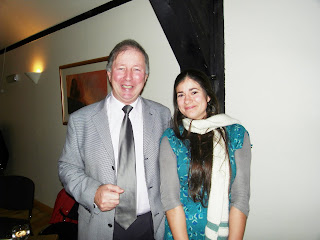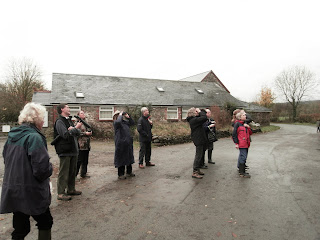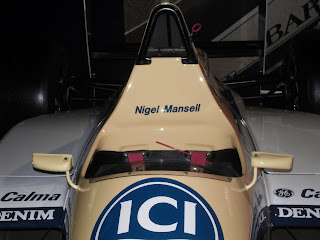
Saturday, 28 November 2009
Farming and the Media

Thursday, 26 November 2009
Carbon Farmprints
- managing nitrogen input and ensuring it has a benefit
- don't convert forest to agriculture
- identify and breed stock that are genetically suited to production efficiency
- maximize the final product per unit of input.
Monday, 23 November 2009
The Ramblings of Briohny




Briohnylivewalk by bribriwilliams
The Birds and The Briohny
The Marine and Coastal Access bill was passed on November 12th ensuring coastal areas of Great Britain will be protected.


Stellainterview by bribriwilliams
Friday, 20 November 2009
True Taste
Saturday, 7 November 2009
When Briohny Met Barry (aka Shaun Williamson)
 I've got to admit, it's not the best picture of Shaun Williamson and it's not the best picture of me, but hey ho, you can't have it all!
I've got to admit, it's not the best picture of Shaun Williamson and it's not the best picture of me, but hey ho, you can't have it all!deer oh deer oh deer
 I visited a deer farm near Cardiff on Wednesday. I can't reveal the address because of deer poaching problems in South Wales. Even the shop that I stopped in to ask for directions warned me of visiting the farm. The shopkeeper immediately said "you can't go there" to which I had to reassure him that I had an appointment.
I visited a deer farm near Cardiff on Wednesday. I can't reveal the address because of deer poaching problems in South Wales. Even the shop that I stopped in to ask for directions warned me of visiting the farm. The shopkeeper immediately said "you can't go there" to which I had to reassure him that I had an appointment. YFC
Countryside Alliance
Thursday, 5 November 2009
Ray
What? A Journey With Ray Mears
Where? St David’s Hall Cardiff
When? Monday 2nd November
It was my first visit to St David’s Hall and I didn’t really know what to expect, especially as I was going to watch A journey with Ray Mears. Was it theatre in the round where Ray would build a bonfire and the audience would have to move around to see him cook various animals? Or would the auditorium be turned into some jungle like world in which Ray would lead us through and point out all the edible plants?Well, I can tell you, it was neither of those.
Essentially the evening was based around a power point presentation. Ray talked us through a series of interesting photos of his favourite Northern explorers. It may sound like a night round your aunties looking at holiday snaps but I assure you it wasn’t. Having said that, the first half of the show did plod along quite slowly, mainly due to the fact that Ray was going over the background story of what he was going to tell us. A story of exploration, determination and courage.
The Northern Explorer’s that were discussed were Samuel Hearne and David Thompson. Two British explorers’ from the 18th Century that opened up Canada. The Hudson's Bay Company and the fur trade turned Canada into an important trading post. With the increasing demand for fur there was an increasing demand for knowledge of the land. What tribes were out in the wilderness that the white man could trade with? Hearne and Thompson found out.
Ray told us how they managed to navigate through some of the most treacherous conditions on the planet and manage to stay alive amongst native tribes. Ray highlighted the difficulty of their expeditions as they were doing it at a time when there was no high tech equipment, no maps and no guidance. It was only their survival skills that kept them going. Well and the women. Ray mentioned that the women taken on expeditions carried all the packs, did all the cooking and basically did all the work. So nothing has changed then. The explorer’s sometimes didn’t even feed the women, as ‘they would get fat licking their fingers as they cooked’. Again, nothing has changed!
Even so, Samuel Hearne and David Thompson truly are two of Britain’s unsung heroes. It is their journey that Ray Mears tries to emulate in his current television series Ray Mears’ Northern Wilderness. Ray takes us on a journey over the mountains, through the lakes and on a beech canoe until we finally reach the far north. Here Native Inuit’s teach him how to go ice fishing, build a snow house and join in with traditional rituals. The Native people still teach their ancient survival skills to younger generations so they do not fear the country that surrounds them. Along with this Ray also pointed out his best survival tip-determination.
A fascinating story. Ray warned us at the start of the talk that it was serious and not in the slightest bit light hearted. I guess when you are talking about surviving in temperatures as low as -70 C there is no room for jokes.
The evening was like one of his television episodes. Great if you are a die-hard Mears follower. He even did a question and answer session followed by a book signing to ensure his fans got true value for money. I don’t think enjoy is really the right word to describe the evening. I feel more knowledgeable and lucky that I can reach into my cupboard for a can of soup when I’m hungry or get a hot water bottle when I’m cold. I’m glad I saw the show. Ray Mears’ is an amazing guy and exactly like he is on television. Simply Ray Mears.
If you want to know more about Ray Mears check out www.raymears.com or what’s on at St David’s Hall www.stdavidshallcardiff.co.uk
Tuesday, 3 November 2009
Oakland Organics
 Chick chick chick chick chicken, lay a little egg for me. Or don't lay an egg, just get fat so I can kill you an eat you!
Chick chick chick chick chicken, lay a little egg for me. Or don't lay an egg, just get fat so I can kill you an eat you!
Pheasant Fun and F1
 It seems like a recurrent theme combining rural affairs and racing, but it just happens that way!
It seems like a recurrent theme combining rural affairs and racing, but it just happens that way!







